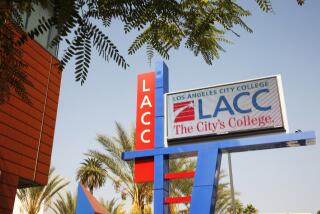Annenberg’s ‘Challenge’ Is a Bust
- Share via
This was supposed to be a banner year for former publisher and diplomat Walter Annenberg, who turned 90 last month. His $500-million, five-year school reform effort, billed as “the largest single gift ever made to American public education,” is due to end this year.
When the gift was announced in December 1993, it fueled the imagination of educators and parents nationwide: After so many years of complaints from education officials and union leaders about an alleged lack of funds, could this be the solution to our public schools’ dismal performance? There seemed little doubt that Annenberg had made a great social investment certain to improve children’s lives and America’s future.
But today, as the Annenberg Challenge proceeds into its fifth and final year, all hopes have diminished. The promised improvements have not been realized.
Does Annenberg realize that the gift that was to be his great legacy has failed to prompt any lasting, significant reform? Instead, his gift has taught other philanthropists where not to invest their fortunes: in the large, unwieldy public school system that favors bureaucracy over the needs of children.
Since 1993, the Annenberg Challenge has distributed grants from the billionaire’s family foundation to programs in rural and urban school districts, including Boston, Chicago, Detroit, Los Angeles, New York, Philadelphia and San Francisco.
Observers cite significant problems in several Annenberg-funded programs. These include mismanagement, lack of effective leadership, lack of teacher commitment, staffing difficulties, poor facilities and inflexible curricula--all endemic to the public school system.
But if the Annenberg Challenge has failed to prompt significant school reform, there is one simple reason: Annenberg relies on the power of money to influence change in a government bureaucracy. Only two elements distinguish the Annenberg Challenge from other failed school reform efforts in the past: large grants from the Annenberg Foundation and Annenberg’s success in leveraging support by requiring matching contributions.
But money is not the answer. The National Center for Education Statistics estimates that the U.S. spent more than $274 billion on public education last year. Could $500 million over five years, even if tripled by matching contributions, have any significant effect?
Not likely. Average per-pupil expenditures (excluding capital expenditures) in U.S. public schools increased, in constant dollars, from $2,153 in 1960 to $6,123 in 1995 without improved performance. By contrast, private schools, which tend to provide more rigorous programs with better results, charged an average tuition of $3,116 in 1993-94 (the most recent data available). The tuition for Catholic schools was only $2,178.
The Annenberg Challenge simply increases the money flow to a system that diverts grants to serve the interests of politics and bureaucracy. By reducing the need for tax revenues that might have been allocated to similar projects, the challenge enables administrators and nonteaching personnel to fill their pockets with the largess of school reform.
Veteran school reformer Theodore R. Sizer, who in 1996 quit as director of the Annenberg Institute for School Reform, admits problems with Annenberg’s approach: “If I had been king, I would have spent a lot less time negotiating through the system as it was and is and much more time in funding “different’ systems,” Sizer told Education Week. “I just don’t think that putting the control in the hands of the existing hierarchy is going to do it.”
Not surprisingly, the challenge has kept silent about its poor results. Annual evaluations of the challenge’s progress promised in 1993 have never been completed.
But the public can see the results. Providing large sums of money to a top-heavy, inefficient system is not going to improve learning. Only reforms that apply external pressure on public schools, such as unfettered competition from private schools through parental choice, are likely to make a difference.
Philanthropists who want to make their mark on America’s schools should follow the example of investors Theodore Forstmann and John Walton, who each gave $3 million last year to a scholarship program for low-income children in Washington. At least 1,000 children will be able to receive a good education at private schools, putting pressure on District of Columbia public schools to improve.
Competition: that’s where the true challenge to reform begins.
More to Read
Sign up for Essential California
The most important California stories and recommendations in your inbox every morning.
You may occasionally receive promotional content from the Los Angeles Times.













